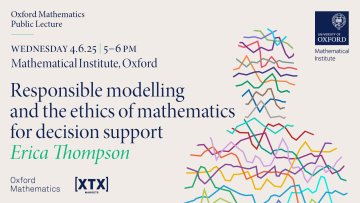Alexandre Tsybakov (CREST, ENSAE, Institut Polytechnique de Paris and pictured) - Gradient-free stochastic optimization
3pm, June 6th, L1, Andrew Wiles Building
Full details plus a 'Distinguished Speaker' seminar on Bayesian Probabilistic Subnational Population Projections
Oxford Mathematics Public Lecture - Wednesday 4 June, 5pm, L1
Mathematical models are used to inform decisions across many sectors including climate change, finance, and epidemics. But models are not perfect representations of the real world – they are partial, uncertain and often biased. What, then, does responsible modelling look like? And how can we apply this ethical framework to new AI modelling methods?
The College Store, who sell our stash, including the new Oxford Mathematics Backpack, are running a discount week (a ten day week) from today Friday 23rd May to Sunday 1st June.
Just click here and use the code TRINITY10.


